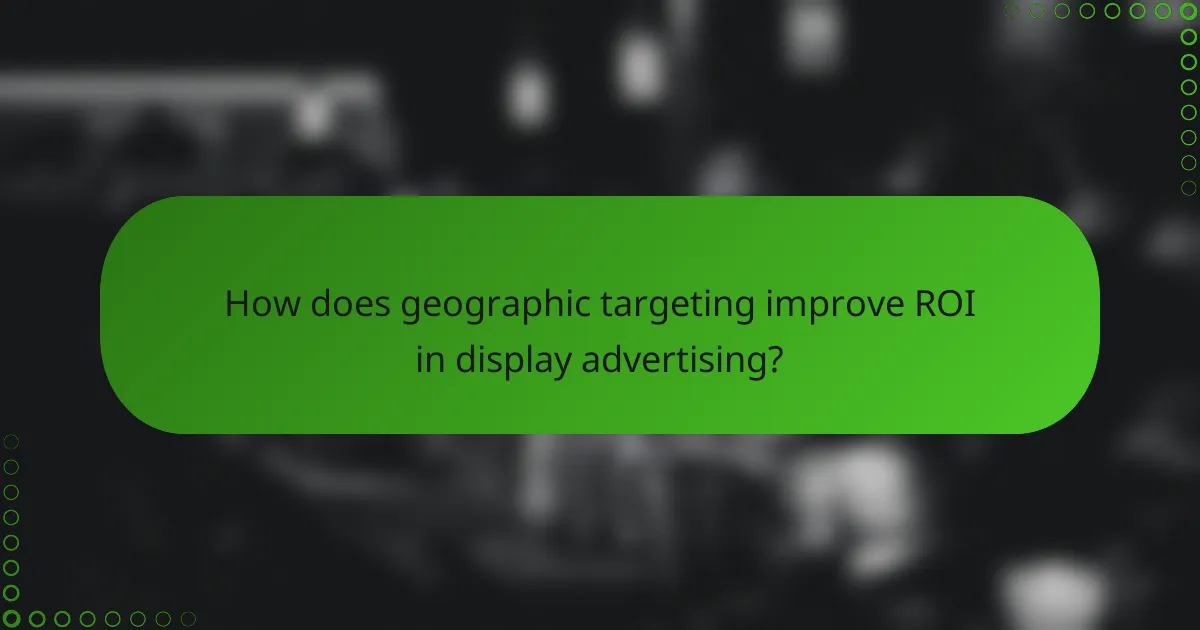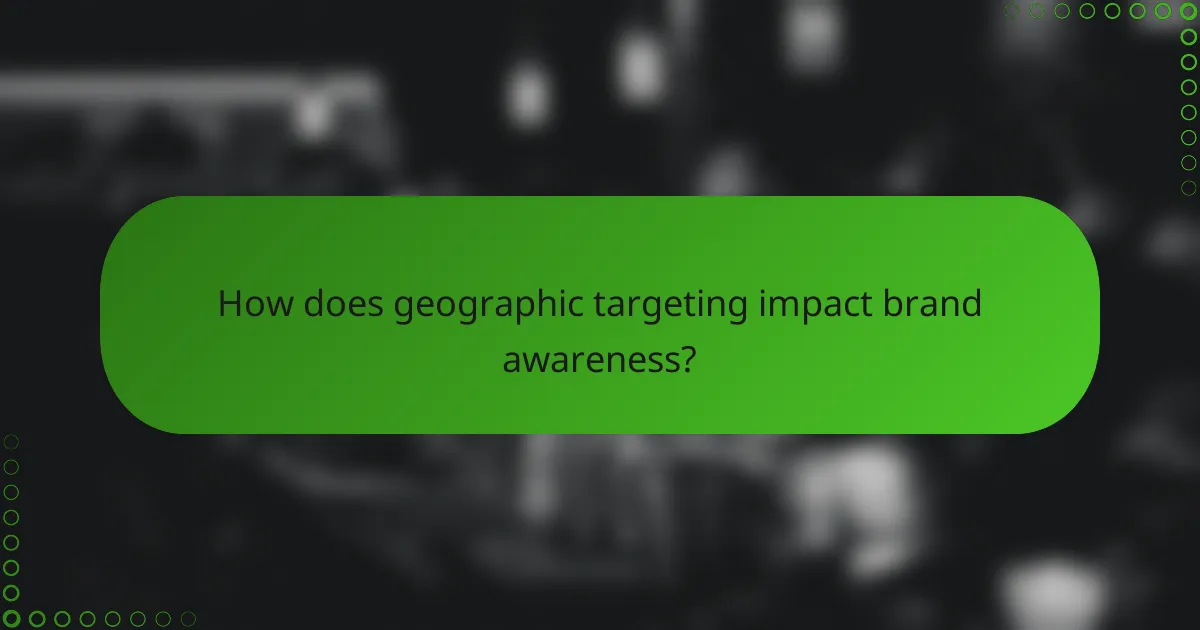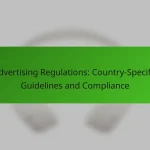Geographic targeting is a powerful strategy that boosts ROI in display advertising by delivering ads to the most relevant audiences based on their location. By tailoring messages to local preferences, businesses can create more effective campaigns that resonate with specific communities. Key metrics such as impressions, click-through rates, and conversion rates provide valuable insights into the effectiveness of these targeted efforts, enabling data-driven adjustments for improved results.

How does geographic targeting improve ROI in display advertising?
Geographic targeting enhances ROI in display advertising by ensuring that ads reach the most relevant audiences based on their location. This precision leads to more effective campaigns, as businesses can tailor their messages to local preferences and needs.
Increased ad relevance
Geographic targeting increases ad relevance by allowing advertisers to customize their content for specific regions. For example, a restaurant chain can promote local menu items or special offers that resonate with the community, making the ads more appealing to potential customers.
By focusing on local interests and cultural nuances, businesses can create a stronger connection with their audience, leading to higher engagement rates. This relevance not only captures attention but also fosters brand loyalty.
Higher conversion rates
Targeting specific geographic areas often results in higher conversion rates. When ads are tailored to local audiences, they are more likely to meet the immediate needs and preferences of consumers, encouraging them to take action.
For instance, a retail store advertising a sale on winter clothing in a region experiencing cold weather is more likely to convert viewers into buyers than a generic ad. This localized approach can lead to conversion increases of several percentage points compared to broader campaigns.
Cost-effective campaigns
Geographic targeting can lead to more cost-effective advertising campaigns by reducing wasted impressions. By focusing on specific locations, advertisers can allocate their budget more efficiently, ensuring that funds are spent on reaching the right audience.
Additionally, local targeting often results in lower cost-per-click (CPC) rates, as competition may be less intense in certain areas. Businesses can maximize their advertising spend by concentrating on regions where they have a stronger market presence or where demand is higher.

What are the key metrics for measuring local reach?
Key metrics for measuring local reach include impressions, click-through rates, and conversion rates, all of which help assess the effectiveness of geographic targeting. These metrics provide insights into how well your marketing efforts resonate within specific areas, allowing for data-driven adjustments to improve ROI.
Impressions in targeted areas
Impressions indicate how many times your ads are displayed in specific geographic locations. Tracking impressions helps determine the visibility of your campaigns and can reveal which areas are most engaged. For example, if an ad receives thousands of impressions in a city but low engagement, it may signal a need for creative adjustments or better targeting.
To effectively measure impressions, use tools that segment data by location. This allows you to compare performance across different regions, helping to identify high-potential markets or areas needing improvement.
Click-through rates by location
Click-through rates (CTR) measure the percentage of users who click on your ad after seeing it, providing insight into the effectiveness of your messaging in specific areas. A higher CTR in a particular region suggests that your content resonates well with that audience. For instance, a CTR of 2-5% is generally considered good, but this can vary by industry and location.
To enhance CTR, tailor your ad copy and visuals to reflect local culture and preferences. A/B testing different messages in various regions can also help identify what drives higher engagement.
Conversion rates per region
Conversion rates indicate the percentage of users who take a desired action, such as making a purchase or signing up for a newsletter, after clicking on your ad. This metric is crucial for assessing the effectiveness of your local targeting strategy. A conversion rate of 1-3% is often seen as average, but this can differ based on the product and market.
To improve conversion rates, ensure that your landing pages are optimized for local audiences, featuring relevant content and offers. Analyzing conversion data by region can help pinpoint successful strategies and areas needing further refinement.

How can businesses optimize local targeting strategies?
Businesses can optimize local targeting strategies by leveraging technology and techniques that focus on specific geographic areas. This approach enhances engagement and improves return on investment (ROI) by reaching the right audience at the right time.
Utilizing geofencing technology
Geofencing technology allows businesses to create virtual boundaries around specific locations. When potential customers enter these areas, they can receive targeted notifications or advertisements, increasing the likelihood of engagement. This method is particularly effective for retail businesses looking to drive foot traffic.
To implement geofencing, businesses should define their target areas based on customer demographics and behavior. Consider testing different radii, such as 500 meters to 1 kilometer, to find the optimal distance for your audience. Regularly analyze the data to refine your geofencing strategy.
Leveraging local SEO techniques
Local SEO techniques enhance a business’s visibility in local search results, making it easier for potential customers to find them. This involves optimizing website content with location-specific keywords, claiming local business listings, and encouraging customer reviews. These actions can significantly improve organic search rankings.
Businesses should focus on creating content that resonates with local audiences, such as blog posts about community events or local partnerships. Additionally, ensuring that your NAP (Name, Address, Phone number) information is consistent across all platforms is crucial for local SEO success.
Implementing location-based ad creatives
Location-based ad creatives tailor marketing messages to specific geographic areas, making them more relevant to the audience. This can include using local landmarks in visuals or referencing local events in the ad copy. Such personalization can lead to higher engagement rates and conversions.
When creating location-based ads, consider testing different messages for various regions to see what resonates best. Utilize analytics to track performance and adjust your creatives accordingly. Avoid generic messaging that may not connect with local audiences, as this can dilute the effectiveness of your campaigns.

What tools enhance geographic targeting effectiveness?
Several tools can significantly improve geographic targeting effectiveness by allowing advertisers to reach specific audiences based on their location. Utilizing these tools can enhance return on investment (ROI) and increase local reach by delivering tailored messages to the right demographics.
Google Ads location targeting
Google Ads offers robust location targeting options that let advertisers specify geographic areas for their campaigns. You can target by country, region, city, or even a radius around a specific address, which helps ensure your ads reach potential customers in relevant locations.
When setting up location targeting, consider using location groups to target specific types of locations, such as landmarks or businesses. This feature can help refine your audience further, increasing the likelihood of engagement and conversions.
Facebook Ads geo-targeting features
Facebook Ads provides geo-targeting capabilities that allow advertisers to reach users based on their current location or the location they have listed in their profiles. You can target specific cities, regions, or even a defined radius around a location, making it easier to connect with local audiences.
Utilizing Facebook’s geo-targeting features can enhance ad relevance. For instance, businesses can promote local events or offers to users within a certain distance, which can lead to higher engagement rates and improved ROI.
AdRoll’s location-based retargeting
AdRoll offers location-based retargeting, enabling advertisers to re-engage users who have previously interacted with their website or ads based on their geographic location. This approach helps keep your brand top-of-mind for potential customers who are nearby.
To maximize effectiveness, consider segmenting your retargeting campaigns based on location. Tailoring your messaging to reflect local interests or promotions can significantly improve engagement and conversion rates.

What are the challenges of geographic targeting?
Geographic targeting presents several challenges that can impact its effectiveness and return on investment (ROI). Key issues include navigating data privacy regulations, dealing with inaccurate location data, and managing ad fatigue in local markets.
Data privacy regulations
Data privacy regulations can significantly affect geographic targeting strategies. Laws such as the General Data Protection Regulation (GDPR) in Europe and the California Consumer Privacy Act (CCPA) in the United States impose strict guidelines on how businesses collect and use personal data, including location information.
Marketers must ensure compliance with these regulations to avoid hefty fines and reputational damage. This often requires implementing transparent data collection practices and obtaining explicit consent from users before utilizing their location data for targeted advertising.
Inaccurate location data
Inaccurate location data can undermine the effectiveness of geographic targeting campaigns. Factors such as VPN usage, mobile device settings, and outdated information can lead to misidentification of a user’s true location, resulting in irrelevant ads being served.
To mitigate this issue, businesses should invest in reliable data sources and regularly update their location databases. Utilizing multiple data points, such as GPS, Wi-Fi triangulation, and user input, can enhance accuracy and improve targeting precision.
Ad fatigue in local markets
Ad fatigue occurs when users in a specific geographic area are repeatedly exposed to the same advertisements, leading to decreased engagement and effectiveness. This is particularly common in smaller markets where the audience size is limited.
To combat ad fatigue, marketers should rotate ad creatives frequently and segment their audience to deliver more personalized content. Implementing frequency caps can also help manage exposure levels and maintain user interest over time.

How does geographic targeting impact brand awareness?
Geographic targeting significantly enhances brand awareness by tailoring marketing efforts to specific locations, making messages more relevant to local audiences. This approach increases the likelihood of engagement and recognition among potential customers in those areas.
Localized messaging resonates better
Localized messaging is more effective because it speaks directly to the cultural and social nuances of a particular area. When brands use language, imagery, and references that reflect local values, they create a stronger emotional connection with the audience.
For example, a restaurant chain might highlight regional dishes or local ingredients in its advertising, making the campaign feel more personal and relevant. This can lead to higher engagement rates and a more favorable brand perception.
Increased foot traffic to physical stores
Geographic targeting can drive more foot traffic to physical locations by promoting special offers or events that are relevant to local consumers. By using location-based ads, businesses can attract nearby customers who are more likely to visit their stores.
For instance, a local clothing store might run a promotion that is only available to customers within a certain radius, encouraging them to visit in person. This strategy can result in increased sales and stronger customer loyalty.
Enhanced community engagement
Effective geographic targeting fosters community engagement by allowing brands to participate in local events and initiatives. By aligning marketing efforts with community interests, businesses can build trust and rapport with local consumers.
For example, sponsoring a local sports team or participating in community festivals can enhance a brand’s visibility and reputation. Engaging with the community not only raises awareness but also positions the brand as a supportive and integral part of the local landscape.









